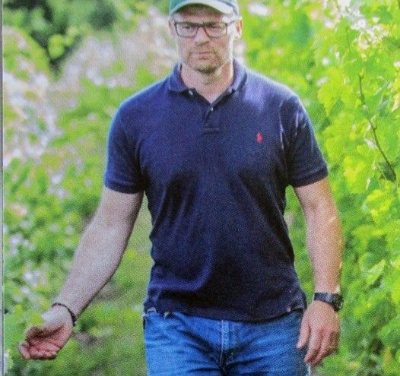Paolo Sabbatini
Quick links: Education Publications Research
Joined the Department
2007
Education
- MS in Horticulture, 1997, University of Ancona (Italy)
- Ph.D. in Horticulture, 2002, University of Ancona (Italy)
- Post-Doctoral Study (2004-2007) Department of Horticulture, Michigan State University
Appointment
- Research 50%
- Extension 40%
- Teaching 10%
Research
Vine Physiology
Research activities focus on wine and juice grapes physiology under Michigan cool climate conditions. The main objective is identifying environmental, physiological and cultural factors that limit vine growth and development, fruit maturity and quality. In particular a) photosynthetic carbon assimilation and partitioning, b) effect of biotic and abiotic stress on vine yield and fruit quality, and c) natural carbon isotope discrimination. The ultimate research goal is to solve whole plant physiological problems that will optimize grape productivity and fruit quality in the field.
Viticulture
Cultural factors limiting vine growth, sustainable yield, fruit maturity and quality are the main areas of research. Canopy management, crop estimation and adjustment and vineyard mechanization are primary focus to better control cultural and physiological factors important for efficient production of high-value grapes.
Cultivar Evaluation
Michigan Grape and Wine Industry Council (MGWIC) aims to increase wine grape production up to 10,000 acres and 3 million cases of Michigan-produced wines annually by 2024. As of 2007, over 53 wineries have been established in Michigan in traditional production regions such as Northern and Southwest Michigan, and less traditional areas such as West Central, South East, Eastern and the Upper Peninsula. The successful expansion of wine grape production will depend on the possibility to grow appropriate varieties for site characteristics. Therefore variety recommendations are crucial and they are based on genetic performance tested in variety trials for Vitis vinifera and mixed species (hybrids) planted in the state of Michigan.
Selected Publications
Rustioni L., Cola G., Vanderweide G., Murad P., Failla O. and P. Sabbatini. 2018. Utilization of a freeze-thaw treatment to enhance phenolic ripening and tannin oxidation of grape seeds in red (Vitis vinifera L.) cultivars. Food Chemistry, 259, pp 139-146.
Vanderweide J., Medina-Meza I.G., Frioni T., Sivilotti P., Falchi R. and P. Sabbatini. 2018. Enhancement of Fruit Technological Maturity and Alteration of the Flavonoid Metabolomic Profile in Merlot (Vitis vinifera L.) by Early Mechanical Leaf Removal. J. Agric. Food Chem. 66, 37, 9839-9849.
Frioni T., Acimovic D., Tombesi S., Sivilotti P., Palliotti A., Poni S. and P. Sabbatini. 2018. Changes in within-shoot carbon partitioning in Pinot Noir grapevines subjected to early basal leaf removal. Frontiers of Plant Sciences; 9, pp 1-11.
Frioni T., Acimovic D., VanderWeide J., Tombesi S., Palliotti A., Gatti M., Poni S and P. Sabbatini. 2019. Whole-Canopy Source-Sink Balance at Bloom Dictates Fruit Set in cv. Pinot noir Subjected to Early Leaf Removal. 2019. Am. J. Enol. Vitic. 70:4 pp 411-419.
Schultze S. and P. Sabbatini. 2019. Implications of a Climate Changed Atmosphere on Cool Climate Viticulture. Journal of Applied Meteorology and Climatology: https://doi.org/10.1175/JAMC-D-18-0183.1
Silvestroni O., Lanari V., Lattanzi T., Palliotti A. and P. Sabbatini. 2019. Canopy management strategies to control yield and grape composition of Montepulciano grapevines. Australian Journal of Grape and Wine Research 25, 30–42.
VanderWeide J., Forte A., Peterlunger E., Sivilotti P., Medina-Meza I.G., Falchi R., Rustioni L. and P. Sabbatini. 2019. Increase in seed tannin extractability and oxidation using a freeze-thaw treatment in cool-climate grown red (Vitis vinifera L.) cultivars. Food Chemistry, https://doi.org/10.1016/j.foodchem.2019.125571
VanderWeide J., Tombesi S., Castellarin S.D, and P. Sabbatini. 2020. Canopy architecture and fruit microclimate, not ripening-related phytohormones, control phenylpropanoid biosynthesis in response to early leaf removal in Merlot (Vitis vinifera L.) grapevines. Plant Physiology and Biochemistry, Volume 157, Pages 291-302.
Poni, S.; Gatti, M.; Tombesi, S.; Squeri, C.; Sabbatini, P.; Rodas, N.L.; Frioni, T. 2020 Double Cropping in Vitis vinifera L. Pinot Noir: Myth or Reality? Agronomy, 10, 799.
VanderWeide J., Forte A., Peterlunger E., Sivilotti P., Medina-Meza I.G., Falchi R., Rustioni L. and P. Sabbatini. 2020. Increase in seed tannin extractability and oxidation using a freeze-thaw treatment in cool-climate grown red (Vitis vinifera L.) cultivars. Food Chemistry, Vol 38 pp 1-10.
Wanyama D, Bunting EL, Goodwin R., Weil N, Sabbatini P and JA Andresen. 2020. Modeling land suitability for Vitis vinifera in Michigan using advanced geospatial data and methods. Atmosphere 11 (339), 1-25.
VanderWeide J, Gottschalk C, Schultze SR, Nasrollahiazar E, Poni S and Sabbatini P. 2021. Impacts of Pre-bloom Leaf Removal on Wine Grape Production and Quality Parameters: A Systematic Review and Meta-Analysis. Front. Plant Sci. 11: 621585. doi: 10.3389/fpls.2020.621585.
VanderWeide J., Frioni T., Ma Z., Stoll M., Poni S., and P. Sabbatini. Early Leaf Removal as a Strategy to Improve Ripening and Lower Cluster Rot in Cool Climate (Vitis vinifera L.) Pinot Grigio. American Journal of Enology and Viticulture 71 (1), 70-79.
Related Work
-
What the vine told us: Post-Great Lakes Expo reflections on smarter viticulture in Michigan
Published on December 15, 2025
-
Get ready for the Michigan Pruning School by Simonit & Sirch coming February 2026
Published on December 8, 2025
-
Michigan grape scouting report – October 8, 2025
Published on October 8, 2025
-
Michigan grape scouting report – October 1, 2025
Published on October 2, 2025
-
From soil to story: Connecting vineyards, science and community at Dirt to Glass 2025
Published on September 26, 2025
-
Michigan grape scouting report – September 24, 2025
Published on September 24, 2025
-
Michigan grape scouting report – September 17, 2025
Published on September 17, 2025
-
Michigan grape scouting report – September 10, 2025
Published on September 11, 2025
-
Michigan grape scouting report – September 4, 2025
Published on September 4, 2025













 Print
Print Email
Email